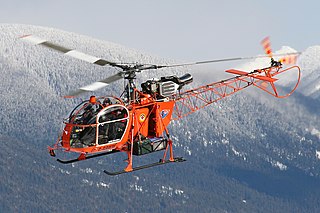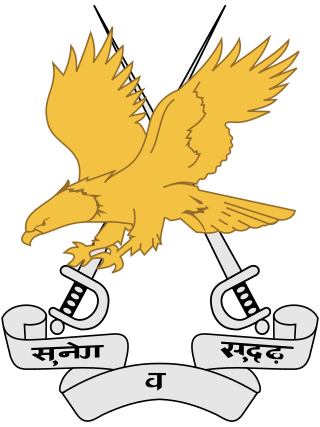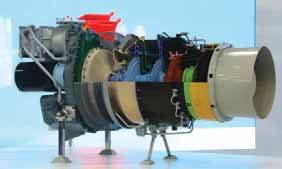
Hindustan Aeronautics Limited (HAL) is an Indian public sector aerospace and defence company, headquartered in Bangalore. Established on 23 December 1940, HAL is one of the oldest and largest aerospace and defence manufacturers in the world. HAL began aircraft manufacturing as early as 1942 with licensed production of Harlow PC-5, Curtiss P-36 Hawk and Vultee A-31 Vengeance for the Indian Air Force. HAL currently has 11 dedicated Research and development (R&D) centres and 21 manufacturing divisions under 4 production units spread across India. HAL is managed by a board of directors appointed by the President of India through the Ministry of Defence, Government of India. In 2024, the company was given Maharatna status. HAL is currently involved in designing and manufacturing of fighter jets, helicopters, jet engine and marine gas turbine engine, avionics, hardware development, spares supply, overhauling and upgrading of Indian military aircraft.

The Eurocopter Tiger is a four-blade, twin-engine attack helicopter which first entered service in 2003. It is manufactured by Airbus Helicopters, which arose from the merger of Aérospatiale's and DASA's respective helicopter divisions. Airbus Helicopters designates it as the EC665. In France and Spain, the Tiger is known as the Tigre, while in Germany and Australia it is referred to as the Tiger.

The Indian Air Force (IAF) is the air arm of the Indian Armed Forces. Its primary mission is to secure Indian airspace and to conduct aerial warfare during armed conflicts. It was officially established on 8 October 1932 as an auxiliary air force of the British Empire which honoured India's aviation service during World War II with the prefix Royal. After India gained independence from United Kingdom in 1947, the name Royal Indian Air Force was kept and served in the name of the Dominion of India. With the transition to a republic in 1950, the prefix Royal was removed.

An attack helicopter is an armed helicopter with the primary role of an attack aircraft, with the offensive capability of engaging ground targets such as enemy infantry, military vehicles and fortifications. Due to their heavy armament they are sometimes called helicopter gunships.

The HAL Dhruv is a utility helicopter designed and developed by Hindustan Aeronautics Limited (HAL) in November 1984. The helicopter first flew in 1992; its development was prolonged due to multiple factors including the Indian Army's requirement for design changes, budget restrictions, and sanctions placed on India following the 1998 Pokhran-II nuclear tests. The name comes from a Sanskrit origin word dhruv which means unshakeable or firm.

Sarang is an aerobatic air display team of the Indian Air Force. Formally established as the No. 151 Helicopter Unit in 2005, the unit flies five modified HAL Dhruv helicopters and is based out of Sulur Air Force Station near Coimbatore in Tamil Nadu.
Aero India is a biennial air show and aviation exhibition held in Bengaluru, India, at the Yelahanka Air Force Station. It is organised by the Defence Exhibition Organisation, Ministry of Defence.

The Aérospatiale SA 315B Lama is a French single-engined helicopter. It combines the lighter Aérospatiale Alouette II airframe with Alouette III components and powerplant. The Lama possesses exceptional high altitude performance.

The Indian Armed Forces are the military forces of the Republic of India. It consists of three professional uniformed services: the Indian Army, Indian Navy, and Indian Air Force. Additionally, the Indian Armed Forces are supported by the Central Armed Police Forces, Indian Coast Guard and Special Frontier Force and various inter-service commands and institutions such as the Strategic Forces Command, the Andaman and Nicobar Command and the Integrated Defence Staff. The President of India is the Supreme Commander of the Indian Armed Forces but the executive authority and responsibility for national security is vested in the Prime Minister of India and their chosen Cabinet Ministers. The Indian Armed Forces are under the management of the Ministry of Defence of the Government of India. With strength of over 1.4 million active personnel, it is the world's second-largest military force and has the world's largest volunteer army. It also has the third-largest defence budget in the world. The Global Firepower Index report lists it as the fourth most-powerful military.
The Indian Naval Air Arm is the aviation branch and a fighting arm of the Indian Navy which is tasked to provide an aircraft carrier-based strike capability, fleet air defence, maritime reconnaissance, and anti-submarine warfare.

The HAL Prachand is an Indian multi-role light attack helicopter designed and manufactured by Hindustan Aeronautics Limited (HAL) under Project Light Combat Helicopter (LCH). It has been ordered by the Indian Air Force (IAF) and the Indian Army's Aviation Corps (AAC). On 3 October 2022, the LCH was formally inducted into the IAF and was officially named "Prachand".

The Nag missile, also called "Prospina" for the land-attack version, is an Indian third-generation, all-weather, fire-and-forget, lock-on after launch, anti-tank guided missile (ATGM) with an operational range of 500 m to 20 km depending on variant. It has a single-shot hit probability of 90% and a ten-year, maintenance-free shelf life. The Nag has five variants under development: a land version, for a mast-mounted system; the helicopter-launched Nag (HELINA) also known as Dhruvastra; a "man-portable" version (MPATGM); an air-launched version which will replace the current imaging infra-red (IIR) to millimetric-wave (mmW) active radar homing seeker; and the Nag Missile Carrier (NAMICA) "tank buster", which is a modified BMP-2 infantry fighting vehicle (IFV) produced under license in India by Ordnance Factory Medak (OFMK).

The Indian Multi Role Helicopter (IMRH) is a medium-lift helicopter currently under development by Hindustan Aeronautics Limited (HAL) for the Indian Armed Forces. It is designed for multiple roles, air assault, air-attack, anti-submarine, anti-surface, military transport and VIP transport roles. IMRH is aimed to replace all the current Mil Mi-17 and Mil Mi-8 helicopters across the Indian Armed Forces.

The Army Aviation Corps (AAC) is the youngest arm of the Indian Army, being formally designated on 1 November 1986. The Army Aviation Corps units are designated as Squadrons. Each squadron generally consists of two Flights. Reconnaissance (Recce) and Observation flights might be part of squadrons or operate independently. The latter do not have a parent squadron and are designated by an (I) in their name.
The Indian Air Force has been undergoing a modernization program to replace and upgrade outdated equipment since the late 1990s to meet modern standards. For that reason, it has started procuring and developing aircraft, weapons, associated technologies, and infrastructures. Some of these programs date back to the late 1980s. The primary focus of current modernization and upgrades is to replace aircraft purchased from the Soviet Union that currently form the backbone of the air force.
Iron Fist is an Indian Air Force exercise held at Pokhran, Rajasthan. It has been held twice: 2013 and 2016.
No. 116 Helicopter Unit (Tankbusters) is a Helicopter Unit that is equipped with HAL Rudra and the HAL Chetak, and based at Jodhpur Air Force Station.

The HAL HTSE-1200 is a turboshaft engine under development by India's Hindustan Aeronautics Limited (HAL). It is aimed at 3.5 ton single engine class and 5-8 ton twin engine class helicopter configurations. India will need 5,000-6,000 helicopters to operate in 2020s. This will be an indigenous design giving engine alternatives for the HAL-developed LUH, ALH and LCH. The first run of engine was conducted in February 2018 when it achieved 76% of the rpm required.
The INAS 323 is an Indian naval air squadron based at INS Hansa, Goa. It operates the multi-role helicopter HAL Dhruv in maritime configuration. The primary role of the squadron is Search and Rescue, Special Operations and Coastal Surveillance.



















